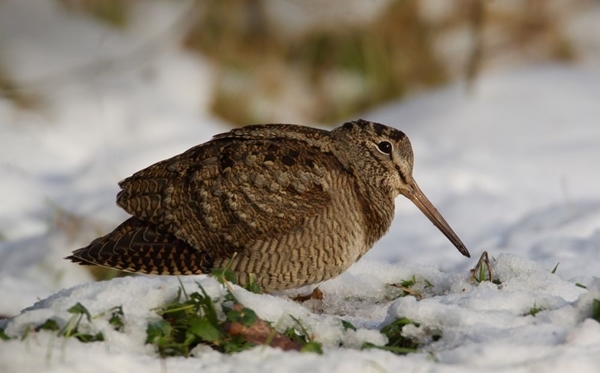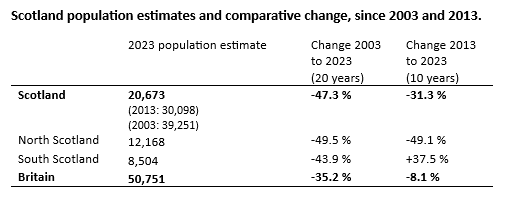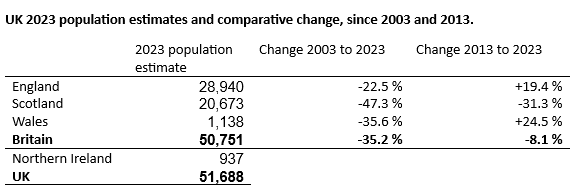
Photo by Liz Cutting
The latest survey of the UK’s resident Woodcock population has shown that in the past ten years the Scottish population has dropped from around 30,000 birds in 2013, to just over 20,000 in 2023.
The Game & Wildlife Conservation Trust (GWCT) and the British Trust for Ornithology (BTO) teamed up in 2023 for the latest Breeding Woodcock Survey to gather up-to-date evidence on the changes to population size and distribution of this elusive bird. The Woodcock is a unique woodland wader, whose cryptic camouflage and secretive nocturnal behaviour have traditionally made it difficult to accurately survey.
Northern Scotland has traditionally always supported a large proportion of the British woodcock population. While previous surveys suggested populations here were broadly stable, Northern Scotland has recorded a sharp decline of 49% between 2013 and 2023.
Southern Scotland, on the other hand, recorded an increase of 37% over the same period. But it is the large decline in Northern Scotland that has dictated the national trend for Scotland, and Britain as a whole, given that up to two-fifths of the British population reside north of Oban/Perth.
Dr Chris Heward, of GWCT, which leads the way in Woodcock research in the UK, says: “A significant reduction in Northern Scotland’s large breeding population, means that woodcock are still declining nationally despite small increases in England and Wales. Understanding why, is the important next step.”

Dr Greg Conway, Senior Research Ecologist at BTO, the UK’s largest bird monitoring and research organisation, says: “Collecting robust survey data is essential for accurately monitoring the ongoing changes to the declining UK breeding Woodcock population. The rapid loss of 35% (27,500 males) of the British population in just two decades is a major cause for concern.”
In 2023 more volunteers than ever contributed, and the results showed some encouraging signs that in parts of England numbers of breeding Woodcock were increasing.
Chris says: “I am grateful for the record-breaking response to our call for Woodcock surveyors, it has made the 2023 Breeding Woodcock Survey the most accurate to date. This once-in-a-decade survey provides a vital snapshot of the Woodcock’s status, and this time it has presented us with a conflicting message, predominantly of worrying declines but with small, tentative glimmers of recovery in some areas.”
The joint GWCT/BTO survey was first carried out in 2003, repeated in 2013 and again last year, and the results will help to inform Woodcock conservation. It looks specifically at the Woodcock that are present all year round and breed in the UK (as opposed to the migratory Woodcock that only visit the UK in winter). Conservation organisations have been aware of long-term reduction in both the breeding population and range, the latter resulting in the species being added to the Red List of the UK Birds of Conservation Concern in 2015.
Woodcock spend much of the day hidden away on forest floors, but in spring and summer the males emerge at dusk to perform distinctive display flights over the woodland canopy, squeaking and grunting as they go, searching for females who await in glades and rides below. It is during these ‘roding’ flights they are most detectible, and this provides a means of counting an otherwise inconspicuous species.
More than 1,200 randomly selected survey sites throughout the UK were visited last year by volunteers to observe the twilight activities of the birds, and to count the roding flights. Even sites where Woodcock went unrecorded helped provide vital information on the changing distribution of the species. The number of sites surveyed was up 50% compared to 2003 and 2013 when only around 800 sites were surveyed.
The results of the 2023 survey gave a new British Woodcock population estimate of 50,750 males, which highlighted the continuing decline across Britain as a whole – a reduction of 8% since 2013, and 35% since 2003.
Small increases in England and Wales since 2013 were offset by a substantial reduction in Scotland, the core stronghold of Britain’s breeding Woodcock population. In North Scotland, in particular, Woodcock numbers fell by 49%, and this was primarily responsible for an overall UK reduction of 8%.
Woodcock were surveyed in Northern Ireland for the first time in 2023, providing an estimate of 937 males and a baseline against which to measure future change. This gave the first complete UK Woodcock population estimate of 51,687 males.
Britain’s breeding Woodcock are mainly sedentary and remain here year-round, while around one million migratory birds from the continent may join them during the winter months.
 Photo by Hugh Insley
Photo by Hugh Insley
Causes for the declines in breeding birds is poorly understood, though there is a high likelihood that it is connected to a reduction in the availability of suitable woodland habitats, along with other external factors affecting breeding productivity and survival.
Chris adds: “Quantifying Woodcock declines is important, but the most pressing issue now is to understand the causes of this change. Comparing the very different fates we’re observing in parts of England and Scotland, may help provide clues as to where future research and conservation strategies should focus.”
“Existing research suggest that there are specific types of woodland that are more valuable to Woodcock, and this may relate to woodland age and management. We suspect Woodcock populations are responding to the overarching, long-term patterns in woodland planting, and it’s these complex relationships we want to unpick next.”
Greg says: “Long term monitoring is essential for providing insights into the regional factors that impact the UK Woodcock population. The 2023 baseline will also allow us to measure the effectiveness of future habitat management and other conservation policies for breeding Woodcock”.
Further research into the causes of the decline will now be carried out using the 2023 result.
In conjunction with the ten-yearly surveys, GWCT and BTO coordinate annual monitoring at a few hundred sites across the UK. This is set to continue post the 2023 survey.
Greg says: “If you found Woodcock on the survey in 2023, I would encourage you to revisit your square. This provides us with extra information about year-by-year fluctuations as well as an early indication of population change. For more information on how to take part, please visit: www.bto.org/woodcock.”
Commenting on the unprecedentedly high participation of volunteers in the 2023 survey, which broke all previous records, Greg adds: “We are grateful to the 1084 volunteers who took part in the breeding Woodcock survey and submitted their data. Without them the survey would be impossible.
Acknowledging the difficulty of undertaking the survey due to terrain and access, Chris says: “We are particularly indebted to those that undertook remote or hard-to-reach areas, which has really boosted the representation in Scotland, Northern England and Wales.
“Equally, we are grateful to those who surveyed sites where Woodcock were absent – although disheartening, these counts are very important and confirm where Woodcock are no longer present.”

Notes for editors:
Bird Study article: Population and distribution change of Eurasian Woodcocks Scolopax rusticola breeding in the UK: results of the 2023 Breeding Woodcock Survey
The Game & Wildlife Conservation Trust – providing research-led conservation for a thriving countryside. The GWCT is an independent wildlife conservation charity which has carried out scientific research into Britain’s game and wildlife since the 1930s. We advise farmers and landowners on improving wildlife habitats. We employ 22 post-doctoral scientists and 50 other research staff with expertise in areas such as birds, insects, mammals, farming, fish and statistics. We undertake our own research as well as projects funded by contract and grant-aid from Government and private bodies.
BTO – The British Trust for Ornithology is the UK’s leading bird research charity with a growing membership and up to 60,000 volunteer bird watchers who contribute to surveys and collect information that underpins conservation work in the UK. It focuses on understanding birds and, in particular, how and why bird populations are changing. Our vision is of a world where people are inspired by birds and informed by science. We aim to increase knowledge of birds and other wildlife, and their relationships with the environment and people.
For more information, or to arrange an interview with Dr Chris Heward, Head of Wetlands Research at GWCT, please contact:
Eleanor Williams – GWCT Communications Officer
ewilliams@gwct.org.uk
Phone: 07592 025476
For more information, or to arrange an interview with Dr Greg, Conway Senior Research Ecologist at BTO, please contact:
Jon Carter – BTO Media Manager
jon.carter@bto.org
Phone: 07585 440910